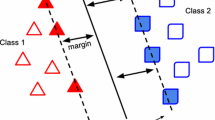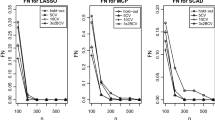Abstract
As an effective approach for multi-input multi-output regression estimation problems, a multi-dimensional support vector regression (SVR), named M-SVR, is generally capable of obtaining better predictions than applying a conventional support vector machine (SVM) independently for each output dimension. However, although there are many generalization error bounds for conventional SVMs, all of them cannot be directly applied to M-SVR. In this paper, a new leave-one-out (LOO) error estimate for M-SVR is derived firstly through a virtual LOO cross-validation procedure. This LOO error estimate can be straightway calculated once a training process ended with less computational complexity than traditional LOO method. Based on this LOO estimate, a new model selection methods for M-SVR based on multi-objective optimization strategy is further proposed in this paper. Experiments on toy noisy function regression and practical engineering data set, that is, dynamic load identification on cylinder vibration system, are both conducted, demonstrating comparable results of the proposed method in terms of generalization performance and computational cost.







Similar content being viewed by others
References
Vapnik VN (1995) The nature of statistical learning theory. Springer, New York
Schölkopf B, Smola AJ (2002) Learning with Kernels. MIT Press, Cambridge
Vapnik VN, Golowich S, Smola AJ (1997) Support vector method for function approximation, regression estimation, and signal processing. In: Mozer M, Jordan M, Petsche T (eds) Advances in neural information processing systems, vol 9. MIT Press, Cambridge, pp 281–287
Smola AJ, Schölkopf B (1998) A tutorial on support vector regression. NeuroCOLT Technical Report TR, Royal Holloway College, London
Li JW, Wang YH, Wu Q, Wei YF, An JL (2008) EEG source localization of ERP based on multidimensional support vector regression approach. In: Proceedings of 2008 international conference on machine learning and cybernetics. IEEE Press, Kunming, China, pp 1238–1243
Pérez-Cruz F, Camps-Valls G, Soria-Olivas E et al (2002) Multi-dimensional function approximation and regression estimation. Lect Notes Comput Sci 2415/2002:757–762
Sánchez-fernández M, De-prado-cumplido M, Arenas-garcía J, Pérez-Cruz F (2004) SVM multiregression for nonlinear channel estimation in multiple-input multiple-output systems. IEEE Trans Signal Process 52(8):2298–2307
Tuia D, Verrelst J, Alonso L, Pérez-Cruz F, Camps-Valls G (2011) Multioutput support vector regression for remote sensing biophysical parameter estimation. IEEE Lett Geosci Rem Sens 8:804–808
Chapelle O, Vapnik V (2000) Model selection for support vector machines. In: Solla SA, Leen TK, Müller KR (eds) Advances in neural information processing systems, vol 12. MIT Press, Cambridge, pp 230–236
Huang CM, Lee YJ, Lin Dennis KJ, Huang SY (2007) Model selection for support vector machines via uniform design. Comput Stat Data An 52(1):335–346
Kohavi R (1995) A study of cross-validation and bootstrap for accuracy estimation and model selection. In: Proceedings of 14th international conference on artificial intelligence (IJCAI), Morgan Kaufmann, Montral, Canada, August 20–25, pp 1137–1143
Chapelle O, Vapnik VN, Bousquet O, Mukherjee S (2002) Choosing multiple parameters for support vector machines. J Mach Learn Res 46(1):131–159
Vapnik VN, Chapelle O (2000) Bounds on error expectation for support vector machines. Neural Comput 12(9):2013–2036
Chung KM, Kao WC, Sun CL, Wang LL, Lin CJ (2003) Radius margin bounds for support vector machines with the RBF Kernel. Neural Comput 15(11):2643–2681
Xu ZB, Dai MW, Meng DY (2009) Fast and efficient strategies for model selection of Gaussian support vector machine. IEEE Trans Syst Man Cybern Part B Cybern 39(5):1292–1307
Chang MW, Lin CJ (2005) Leave-one-out bounds for support vector regression model selection. Neural Comput 17(5):1188–1222
Cawley GC, Talbot NLC (2007) Preventing over-fitting in model selection via Bayesian regularisation of the hyper-parameters. J Mach Learn Res 8:841–861
Li S, Tan M (2010) Tuning SVM parameters by using a hybrid CLPSO-BFGS algorithm. Neurocomputing 73:2089–2096
Avci E (2009) Selecting of the optimal feature subset and kernel parameters in digital modulation classification by using hybrid genetic algorithm-support vector machines: HGASVM. Expert Syst Appl 36:1391–1402
Mao WT, Tian M, Yan GR (2012) Research of load identification based on multiple-input multiple-output SVM model selection. In: Proceedings of the institution of mechanical engineers, Part C: J Mech Eng Sci 226(5):1395–1409
Evgeniou T, Pontil M (2004) Regularized multi-task learning. In: Proceedings of tenth ACM SIGKDD international conference on knowledge discovery and data mining (KDD), Seattle, USA, pp 109–117
Mao WT, Yan GR, Dong LL, Hu DK (2011) Model selection for least squares support vector regressions based on small-world strategy. Expert Syst Appl 38(4):3227–3237
Tikhonov AN (1998) Nonlinear ill-posed problems. Chapman & Hall, London
Allen DM (1974) The relationship between variable selection and prediction. Technometrics 16:125–127
Huang VL, Suganthan PN, Liang JJ (2006) Comprehensive learning particle swarm optimizer for solving multiobjective optimization problems. Int J Intell Syst 21:209–226
Acknowledgments
We thank the author Suganthan [25] for providing implementation of MOCLPSO. This work was supported by National Natural Science Foundation of China (No. U1204609) and Foundation and Advanced Technology Research Program of Henan Province, China (No.122300410111).
Author information
Authors and Affiliations
Corresponding author
Rights and permissions
About this article
Cite this article
Mao, W., Mu, X., Zheng, Y. et al. Leave-one-out cross-validation-based model selection for multi-input multi-output support vector machine. Neural Comput & Applic 24, 441–451 (2014). https://doi.org/10.1007/s00521-012-1234-5
Received:
Accepted:
Published:
Issue Date:
DOI: https://doi.org/10.1007/s00521-012-1234-5




